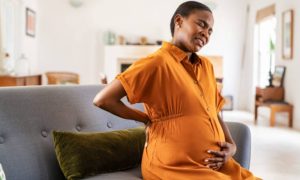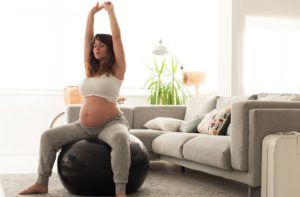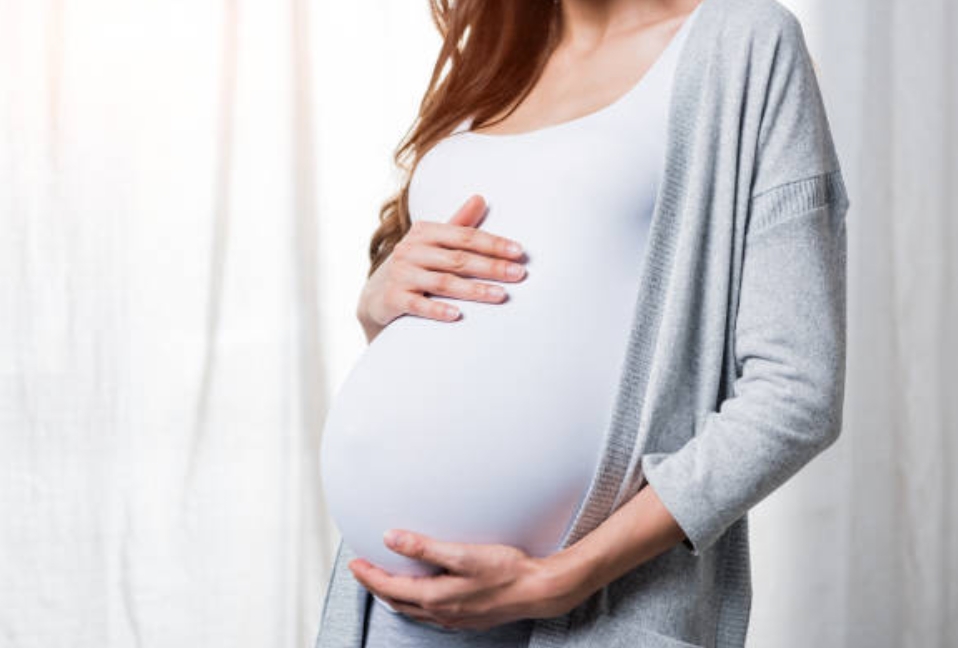Back discomfort is a frequent, but not universal, symptom of pregnancy for many women. This blog compiles some of the evidence linked to prevalence and makes some management recommendations.
Prevalence

Back discomfort is reported by 47% to 80% of pregnant women at some stage during their pregnancy (Mantle et al. 1977; Gent D. and Hottlieb K. 1985; Berg et al. 1988; Ostgaard et al. 1991, 1994a; Kristiansson 1996a; Sturesson et al. 1997; Nilsson-Wikmar L, et al. 1997; Nilsson-Wikmar L, et al. The average statistic indicates that back pain affects slightly more than half of pregnant women. This contrasts with a one-year prevalence rate of around 40% in the general population. This means that back discomfort is more common among pregnant women than in the general population. This condition causes missed work days, reduced functional capacity, and lower quality of life scores. Furthermore, symptoms may persist in the postpartum period, with prevalence in as many as 68% of women lasting up to 12 months (Nilsson-Wikmar L, et al., 2005; Olsson C, and Nilsson-Wikmar L, 2004).
Natural history
Back pain during pregnancy is not a constant but rather changes throughout the trimesters. The most typical time for onset is during the third to seventh months of pregnancy (Fast et al., 1987; Mantle et al., 1977), and back discomfort worsens as the pregnancy progresses (Ostgaard et al., 1997a; Kristiansson et al., 1996a). There is a rapid decrease in back pain following birth. The incidence of back discomfort during pregnancy is significantly higher, accounting for the overall rise in back pain. Ostgaard et al. (1997a) discovered that 18% of 362 women reported back discomfort before pregnancy, 71% throughout pregnancy, and 16% six years thereafter. The impact and degree of back discomfort during pregnancy vary. Only about 20% appear to have chronic discomfort, with intermittent symptoms far more common (Berg et al., 1988; Fast et al., 1987). In general, the severity of pain tends to increase as pregnancy progresses.
Risk factors for back pain in pregnancy
A prior history of back pain, mechanical and psychosocial pressures at work, the hormonal impacts of pregnancy, and the method of birth are the greatest and most consistent connections with back pain throughout pregnancy.
Lordosis and pregnancy
The biomechanical response to pregnancy varies among women and during different stages of pregnancy. Ostgaard et al. (1993) discovered no difference in lumbar lordosis between the twelfth and thirty-sixth weeks of pregnancy, but they did discover a strong link between substantial lumbar lordosis and back pain. Bullock et al. (1987) discovered a significant increase in lordos between the eighth and thirty-eighth weeks of pregnancy. There was a 72-degree increase on average, but there was considerable variation, with some women showing a significant increase—one woman’s lordosis increased by 22.3 degrees. Increasing lordosis was connected with increasing height and weight, but there was no correlation with back pain. Dumas et al. (1995) discovered a considerable increase in lordos for up to 32 weeks. After this point, the lordosis increased in multigravidas, whereas it reduced in primagravidas after 32 weeks.
Interventions
Many classic low back exercises, good body mechanics, posture instructions, work skill improvement, and superficial modality application can effectively treat low back pain symptoms (Noble E., 1988; Stephenson R., and O’Connor L., 2000). Deep heating agents, electrical stimulation, and traction are generally not recommended during pregnancy.
Physically fit women experience decreased back pain during pregnancy (Pauls J., 1995).

In fact, the mechanical reaction to pregnancy may be diverse and individual. The tendency for the lordotic curve to grow with pregnancy advancement was linked to an increased risk of back pain. According to reports, one of the mechanical responses to pregnancy is greater lordosis. These women may report feeling significantly worse when standing or walking but much better when sitting, indicating that they respond to the flexion principle. Certain techniques, such as hip abduction, may need to be modified to accommodate the pregnant abdomen. Alternatively, increasing lordosis may produce postural stresses and react to standing postural correction. Other women may respond to the idea of extension. Certain operations are prohibited due to the pregnancy. Women should not lie prone beyond a particular point in time; the exact duration varies. When prone lying or extension in lying are no longer an option, extension in standing is frequently accepted. A certain amount of extension can also be obtained from a four-point kneeling position by dropping the abdomen to the floor. The inability to achieve end-range extension may restrict the effectiveness of these operations and prevent full reduction (McKenzie R, May S. 2003).
Garshasbi and Faghih Zadeh (2005) conducted a prospective randomised trial on the influence of exercise on the intensity of low back pain during pregnancy on over 200 primigravid women (pregnant for the first time). Subjects were excluded if they had a history of pre-pregnancy activity or a history of orthopaedic issues. The exercise group participated in a supervised exercise programme for 12 weeks in the second and early third trimesters, for 3 hours per week; the control group consisted of homemakers who had no significant change in activity level. In terms of maternal and neonatal weight increase, as well as pregnancy length, the groups were statistically equivalent. By the end of the study, the exercise group’s intensity of low back pain had decreased significantly, but the control group’s intensity had increased. The study did not discriminate between postural discomfort and sacroiliac pain or identify the nature of the symptoms. Surprisingly, there was no significant difference in lordosis change between the two groups.
A recent Cochrane Review discovered that pregnancy-specific exercises, such as “water gymnastics,” relieved back or pelvic discomfort better than standard prenatal treatment alone; however, the benefit was minor due to potential bias in the studies (Pennick VE and Young G. 2007).
References
- Berg G, H ammar M, Molier-NielsenJ, Linden U, Thorb lad J (1988) Low back pain during pregnancy. Obstet & Gynaecol 71. 71-75.
- Bullock JE, Lull GA, Bullock Ml (1987). The relationship of low back pain to postural changes during pregnancy. Aus j Physio 33. 10-17.
- Dumas GA, Reid jG, Wolfe LA, Griffin M P, McGrath MJ (1995). Exercise, posture, and back pain during pregnancy. Pan 1. Exercise and posture. Clin Biomech 10. 98-103.
- fast A, Shapiro D, Ducomunn EJ et al. (1987). Low-back pain in pregnancy. Spine 12. 368-371.
- Kristiansson P, Svardsudd K, von Schoultz B (1996a). Back pain during pregnancy A prospective study. Spine 21.702-709.
- Garshasbi, A, and Faghih Zadeh, S: The effect of exercise on the intensity of low back pain in pregnant women. Int J Gynaecol Obstet 88(3):271–275, 2005.
- Gent, D, and Gottlieb, K: Cesarean rehabilitation. Clin Man Phys Ther 5:14, 1985.
- Mantle MJ, Greenwood RM, Currey HLF (1977) Backache in pregnancy. Rheum & Rehab l6.95-101.
- Ostgaard HC, Andersson GBJ, Karlsson K (1991). Prevalence or back pain during pregnancy. Spine 16.549-552.
- McKenzie R, May S (2003). The Lumbar Spine: Mechanical Diagnosis and Therapy (Volumes 1 and 2). Spinal Publications New Zealand Ltd (2nd Edition).
- Nilsson-Wikmar, L, et al: Effect of three different physical therapy treatments on pain and activity in pregnant women with pelvic girdle pain: a randomized clinical trial with 3, 6, and 12 months follow-up postpartum. Spine 30(8):850–856, 2005.
- Noble, E: Essential Exercises for the Childbearing Year, ed. 3. Boston: Houghton Mifflin, 1988.
- Olsson, C, and Nilsson-Wikmar, L: Health-related quality of lifemand physical ability among pregnant women with and without back pain in late pregnancy. Acta Obstet Gynecol Scand 83(4):351–357, 2004.
- Ostgaard HC, Andersson GBJ (1991). Previous back pain and risk or developing back pain in a future pregnancy. Spine 16.432-436.
- Ostgaard HC, Andersson GBJ, Schultz AB, Miller JAA (1993). Influence of some biomechanical ractors on low-back pain in pregnancy. Spine 18.61-65.
- Ostgaard HC, Zetherstrom G, Roos-Hansson E, Svanberg B (1994a). Reduction or back and posterior pelvic pain in pregnancy. Spine 19.894-900.
- Pauls, J: Therapeutic Approaches to Women’s Health: A Program of Exercise and Education. Gaithersburg, MD: Aspen, 1995.
- Pennick, VE, and Young, G: Interventions for preventing and treating pelvic and back pain in pregnancy. Cochrane Database Syst Rev 18(2):CD001139, 2007.
- Stephenson, R, and O’Connor, L: Obstetric and Gynecologic Care in Physical Therapy, ed. 2. Thorofare, NJ: Charles B. Slack, 2000.
- Sturesson B, Uden G, Veelming A (1997). Pain pattern in pregnancy and “catching” of the leg in pregnant women with posterior pelvic pain. Spine 22.1880-1884.
